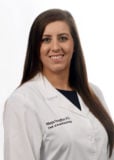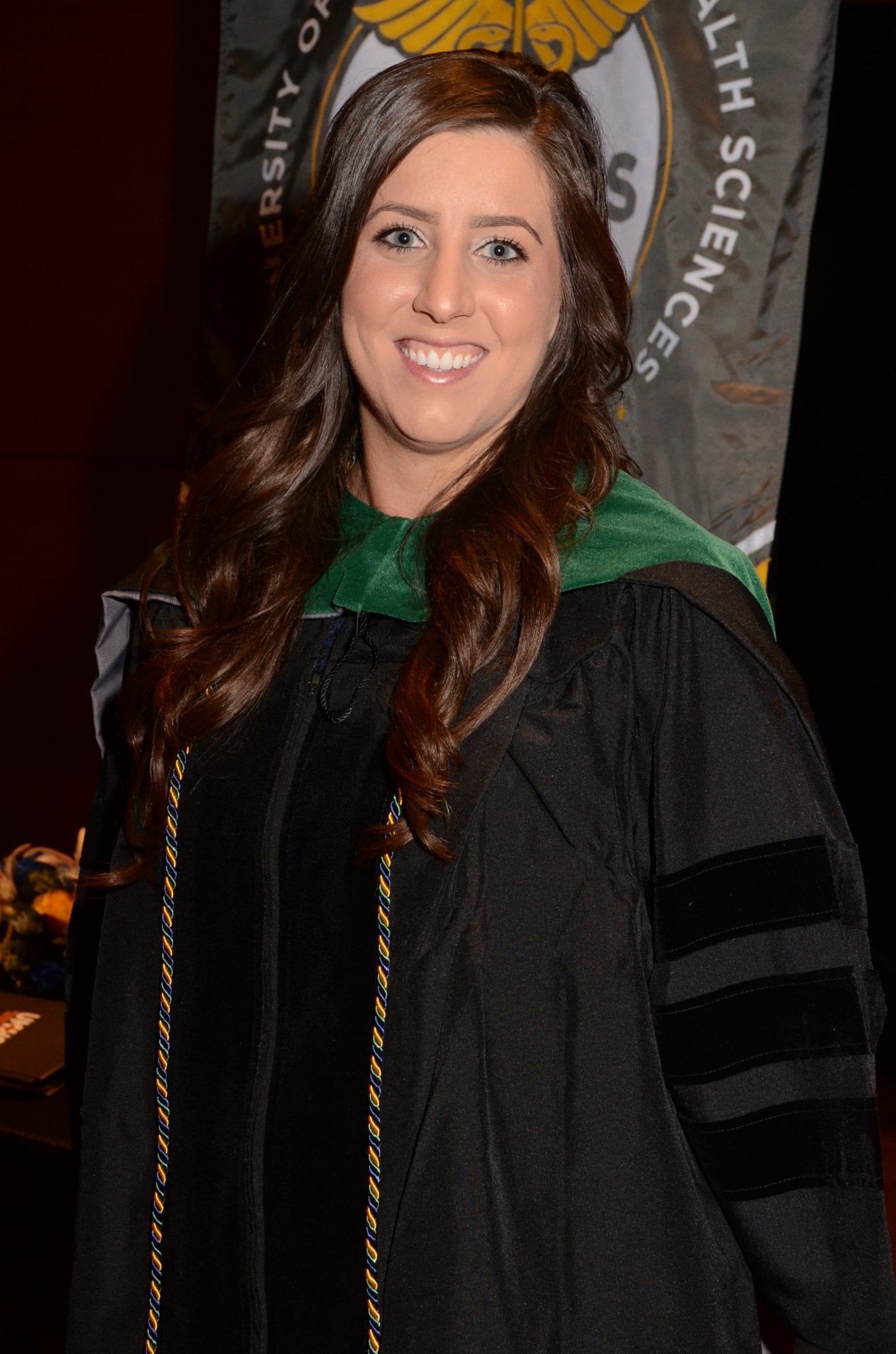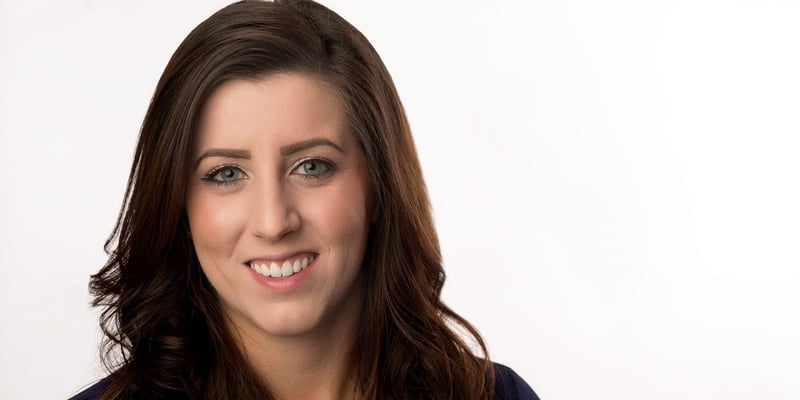The UMHS Endeavour spoke to UMHS 2018 graduate Dr. Mikayla Troughton, an Anesthesiology resident at the University of Arkansas for Medical Sciences (UAMS), about how the COVID-19 pandemic has affected her hospital and job.
COVID-19 has made an impact on Dr. Mikayla Troughton’s UAMS hospital in countless ways. For the fourth installment of our Alumni On the Front Lines series, featuring UMHS graduates working in hospitals around the nation during this public health emergency, the UMHS Endeavour spoke to Dr. Troughton about how the pandemic is changing the way doctors work in hospitals, from new precautions and canceling elective surgeries to new visitor policies, what doctors must know about aerosol-generating procedures, testing, symptoms to look for, the promise of new treatments and more.
Canceling Elective Surgeries & New Policies & Procedures
For Dr. Mikayla Troughton, things have changed a lot for her as a doctor in the past few weeks.
“Since the beginning of COVID-19, each day at the hospital presents new challenges and new recommendations,” she said. “On March 14th the U.S. Surgeon General made an advisement to cancel all elective surgeries and we have been following this advisement at UAMS. As such, our normal routine of being in the operating rooms, or performing epidurals and nerve blocks has significantly slowed down. We have been more actively involved where we are needed, and these areas are either in the critical care units (I am personally in the surgical ICU at this time), the emergency department/triage, or taking care of emergency airways.

(Photo, inset right): Dr. Mikayla Troughton. Photo: Courtesy of Dr. Troughton.
“In order to help protect hospital staff and patients (as well as conserve PPE or Personal Protective Equipment) a new visitor policy was implemented on March 22nd at UAMS, which entails no visitors unless exceptional circumstances apply. We have most recently implemented a ‘COVID Response Team’ within our anesthesiology department. This team essentially breaks our department of 56 residents into groups responsible for covering the main operating rooms vs. performing other tasks or staying at home. We have started limiting the unnecessary number of residents at the hospital if all bases have been covered. Above all, it’s been very important for us to be adaptable to new standards and the new patient population being served because it’s a privilege to be able to help so many people in a time when they feel helpless.”
Numerous adjustments have been made for COVID-19 at the hospital, including a telephone hotline to perform COVID-19 screenings for the general public, and an additional drive-through screening site on campus.
“All hospital entrances have been secured and upon arrival, we are verbally screened and we have our temperature taken,” Dr. Troughton said. “After passing the screening we get a daily sticker to wear on our scrubs. Our ‘reserve’ anesthesiology residents on the ‘COVID Response Team’ are on call 24 hours/7 days per week in case they are needed to replace members of the active team who get sick. Within the hospital, the same precautions apply as before and we’ve been actively following all emerging literature on COVID-19.
Special precautions are made for patients who have tested positive for COVID-19.
“They are placed on droplet and contact precautions at UAMS,” Dr. Troughton said. “Specific to anesthesiology, all intubations are performed in a rapid sequence manner without bag-mask preoxygenation (to prevent aerosolization of particles), preferably with a video laryngoscope which enables the operator to stay further away from the patient’s face and attaching a HEPA filter to the endotracheal tube between the tube and the circuit. In regards to extubation procedures, there have been trials in Toronto where they are extubating COVID-19 patients within a large plastic bag prefilled with heliox [a mixture of helium and oxygen] to keep it open (and contain the reflexive cough). The air within the plastic bag is then evacuated by suction after extubation.”
So far Dr. Troughton has not treated a known COVID-19 patient.
“I have personally not been in contact with a known positive COVID-19 patient, but I have taken care of several patients under investigation,” she said.
As of March 30th, there have been 473 cases with 62 patients hospitalized and 21 of them on ventilators. Of these 473 cases, there are 17 children, 149 seniors, and 307 aged 19-64. 71 of these cases are related to domestic travel. There have been seven deaths in Arkansas, 28 people have recovered and 73 cases are in health care workers, according to statistics released by the Arkansas Society of Anesthesiologists.
At UAMS, all COVID-19 suspected or positive patients are placed on contact and droplet precautions.
“ I personally wear shoes that are easy to wipe off and stay at the hospital in my locker,” Dr. Troughton said “The anesthesiology department at UAMS enacted an Airway Response Team – which entails specific roles for anesthesiology providers involved, as the designated ‘clean’ and ‘contaminated’ person on the team. We carry our backpack for emergent airways (which we carry on a regular basis) – includes our drugs, laryngoscopes, McGrath video scopes, endotracheal tubes, oral airways, etc. We have also implemented a designated COVID-19 response difficult airway cart – which contains extra personal protective equipment for our use (N95s, CAPRs and neck protection) and additional airway equipment, including a flexible bronchoscope.”

Dr. Mikayla Troughton at UMHS graduation in June 2018. Photo: Island Photography/UMHS files.
What Must Doctors Know About Aerosol-Generating Procedures?
Dr. Troughton spoke about the specific risks and precautions for anesthesiologists for COVID-19.
“Of specific interest to my co-residents and I in anesthesiology is aerosols and aerosol generating medical procedures,” she said. “Aerosol-generating medical procedures include: intubation, tracheotomy, manual bag-mask ventilation, bronchoscopy, and it’s currently controversial whether non-invasive methods of ventilation such as CPAP and biPAP fit into this category as well. Aerosols are produced when an air current moves across the surface of a film of liquid, generating small particles at the air-liquid interface. The particle size is inversely related to the velocity of air. Therefore, if a procedure causes air to travel at high speed over the respiratory mucosa and epithelium, the production of aerosols containing infectious agents is a potential risk. In light of PPE supply shortages, the CDC last week changed its recommendations to allow the use of medical masks for routine patient care and saving respirators (N95s, CAPRs) for aerosol generating medical procedures. However, if availability permits and supply chain shortages resolve, N95s should be used by all personnel. COVID-19 is known to be transmissible via droplet transmission and it’s currently controversial whether it’s transmitted via an airborne route.”
Precautions for Known or Suspected COVID-19 Infections
“For those unfamiliar with types of precautions, I will briefly go over them”:
- “Contact precautions are used for patients with known or suspected infections that represent and increased risk for contact transmission. PPE precautions for health care personnel include: glove and gown.”
- “Droplet transmission is defined as “respiratory droplets carrying infectious pathogens [that] transmit infection when they travel directly from the respiratory tract of the infectious individual to susceptible mucosal surfaces of the recipient, generally over short distances, necessitating facial protection.”1 Droplets are considered >5 microns. Source control includes putting a mask on the patient. PPE for health care personnel includes a surgical mask.”
- “Airborne transmission is defined as “dissemination of either airborne droplet nuclei or small particles in the respirable size range (<5 microns) containing infectious agents that remain infective over time and distance.” An important requirement of airborne transmission is that it can occur only at a long distance from the source, according to the CDC.1 A surgical mask should be placed on the patient and a properly fitted N95 mask for healthcare personnel.”
At this time, WHO [World Health Organization] states “COVID-19 appears to spread most easily through close contact with an infected person. When someone who has COVID-19 coughs or sneezes, small droplets are released and, if you are too close, you can breathe in the virus” – However, inhalation is not included in the traditional definition of droplet transmission.1 The bottom line: both WHO and Canadian Guidelines recommend surgical masks for routine care and N95s for aerosol generating procedures.2””
Should COVID-19 Testing Be Increased?
Public health officials have said from the onset of COVID-19 in the U.S. that more testing was needed. Right now, more and more communities are offering COVID-19 testing but Dr. Troughton said right now, tests should be solely done on people with symptoms.
“At this time, I do not recommend routine testing for COVID-19,” she said. “This could be reconsidered when tests are more readily available.”
What symptoms should doctors look for in patients?
“Symptoms that would lead me to suspect COVID-19 would be upper respiratory symptoms, cough, shortness of breath, loss of taste and smell, febrile illness and GI symptoms such as nausea and vomiting. Because these symptoms are vague and tend to be common for many viral or bacterial infections, patients are generally tested for influenza and the respiratory viral panel before being considered for COVID-19 testing. Additionally, a patient should have other risk factors before being tested for COVID-19. These additional risk factors could be close contact with a known COVID-19 positive patient, or living arrangements such as a long-term care facility where other residents have tested positive."
As of three days ago (March 27, 2020), UAMS moved all patients off of the ninth floor of the main hospital (two wings, approximately 60 rooms) and we are in the process of reconstructing conventional inpatient rooms to negative pressure rooms with ICU capabilities.
Ongoing Need for PPE & Ventilators
Nationwide, particularly in large cities, there is a huge demand for PPE and ventilators in hospitals.
“Any opportunity for any large corporation to assist in producing ventilators or other PPE would be extremely helpful in this evolving pandemic and I would support such measures for the entire nation,” Dr. Troughton said. “Several departments have been actively searching literature for ways to combat possible ventilator shortages in the future. We recently had a video shared which demonstrates the ability to connect four separate patients to one ventilator if the situation becomes dire. Obviously, there are several limitations to this method (e.g. all patients would need similar ventilator settings, physical space limitations, patients connected to the same ventilator would need to be affected by the same virus, etc.). Additionally, we just had an American Society of Anesthesiologists Town Hall meeting on March 26th and we will begin re-purposing operating room ventilators as ICU ventilators as needed.”
“At this current time, we at UAMS do not have a supply shortage of ventilators, and we have 14 additional ventilators in shipment. Supply shortages have been on the forefront of discussion recently and we actually just received an update as of March 27th from the Arkansas Society of Anesthesiologists. Arkansas will be receiving 3M N95 masks, 4M surgical masks, 4M plastic gowns, 2.1M face shields, and 7M gloves – these will be distributed amongst the state as needed. [M meaning “million.”]”
Do All COVID-19 Patients Need to be Hospitalized?
COVID-19 can be life-threatening, particularly for the elderly and people with compromised immune systems or other health issues, but many who test positive only experience mild symptoms. Dr. Troughton said not all confirmed COVID-19 patients need to be in the hospital.
“The majority of the population will have been exposed by the time this pandemic is over, and many of us will only have had mild symptoms not requiring hospitalization (>80% of patients),” she said. “COVID-19 patients may require hospitalization if they are at high risk of decompensation due to other comorbidities such as existing asthma, COPD, diabetes with an HbA1c >7.6%, history of CAD, history of transplant or immunosuppression, chronic kidney disease or those with HIV regardless of CD4 count. Anyone with an increased respiratory rate (>24/min), increased work of breathing (use of accessory muscles), tachycardia (>125/min) or those with pulse oximetry <90% on ambient air should be considered for hospitalization and closer monitoring due to possible impending respiratory failure.”
For COVID-19 patients requiring hospitalization, there is no set time limit before someone can be discharged.
“It is purely based off of clinical progression,” Dr. Troughton said. “If a patient ends up intubated due to COVID-19, treat with ARDS [acute respiratory distress syndrome] protocol in mind – avoid fluid boluses for mild hypotension, avoid maintenance fluids in general and target net zero or negative fluid balance, use low dose vasopressors to support MAPs >65. Consider early APRV ventilator strategy, as this also gives you a good indication of lung compliance and severity of respiratory failure. ICU patients often have non-anion gap metabolic acidosis – consider treating with bicarbonate rather than increasing the intensity of mechanical ventilation and thereby threatening the lungs further. Target oxygen saturations of 90% for most cases, as hyperoxia carries its own risks, including free radical damage.”
When can someone be released from the ICU?
“In order for a patient to be transferred out of the ICU, they need to be meeting criteria for extubation (use RSBI and NIF scores) and hemodynamically stable off of all pressors. If respiratory status fails to progress and they are unable to be weaned from the ventilator, they will eventually end up with a tracheostomy. When the patient is tolerating trach collar, they can also likely be transferred to the floor. In order to be discharged from the hospital, they need to be at, or near baseline functioning with regards to cardiovascular and respiratory status. Of note, I have seen some data on prognostication measures for COVID-19. It is thought that prolonged or worsening lymphopenia suggests poorer outcome. Additionally, neutrophil/lymphocyte ratios >3 could suggest a worse prognosis.2 Other markers of inflammation such as CRP, LDH and D-Dimer can be trended, where uptrends can suggest worse prognosis. D-Dimer elevations over 1ug/L was the strongest independent predictor of mortality in a study by Zhou et al.2 Patients tend to deteriorate with progressive DIC and multiorgan failure due to hyperinflammation, vasodilatory shock and myocarditis.”
Treatments & Hope for Vaccine & Cure
There is no clinically proven treatment or “cure” or vaccine to date for COVID-19, but there is hope.
“At this time, literature on treatments for COVID-19 is rapidly emerging and changing. Currently, there is no effective antiviral treatments for COVID-19. The cornerstone supportive therapy is providing sufficient respiratory support in the form of ARDS protocol for intubated patients or resorting to ECMO for those who are not progressing. The investigational drug, Remdesivir (an RNA dependent RNA polymerase inhibitor) is starting to be used in randomized clinical trials or for compassionate use for those who are severely affected in the ICU. Interestingly, statins are being recommended for several reasons including that cardiovascular disease is a major risk factor for COVID-19 disease severity and statins may promote antiviral innate immune response. At this time, cardiogenic shock appears to be contributing to 7-33% of deaths after recovery from the respiratory phase.3 Some institutions have started using hydroxycholoroquine as an off-label use (mechanism of action: prevents binding to ACE2 – which is thought to be implicated as a receptor used by COVID-19 for entrance to pneumocytes).”
What other medications might help?
“Azithromycin [an antibiotic commonly known as Z-Pack] has been used if there is high suspicion for superimposed bacterial pneumonia. Early administration of steroids is not indicated (may increase viral shedding), but steroids may be beneficial in patients suffering from cytokine storm in the later stages or those who are in vasopressor-refractory shock. Tocilizumab is a monoclonal antibody to IL-6 that can also be used to assist in treating cytokine storm. NSAIDs [such as ibuprofen like Advil] should be avoided in patients with COVID-19 as they can worsen symptoms.
Dr. Troughton said patients with milder cases of COVID-19 are being treated with supportive therapy.
“Much of the therapy for mild COVID-19 is similar to the therapy that we would imply for influenza,” she said. “This includes symptom management with OTC medications such as acetaminophen [Tylenol, for example] for pain and fever reduction and oxymetazoline [nasal sprays like Afrin and Nasacort] can be used for sinus congestion for a maximum of 72 hours. Additionally, it is important to get lots of rest, drink water, eat healthy, wash your hands and social distance.”
Dr. Troughton encourages medical students and residents to learn everything possible during this unprecedented global emergency.
“Although this is a very scary time for everyone, take this opportunity to learn as much as you can as a medical student or resident about this novel virus and its management. We are becoming stronger clinicians by having these experiences and much of our learning comes from being in unknown situations. Stay healthy, follow precautions, take time for yourself, FaceTime friends and family, and be safe.”
References
- http://www.cidrap.umn.edu/news-perspective/2020/03/commentary-covid-19-transmission-messages-should-hinge-science
- https://emcrit.org/ibcc/covid19/#prognostication_of_individual_patients
- Ruan, Q., Yang, K., Wang, W. et al.Clinical predictors of mortality due to COVID-19 based on an analysis of data of 150 patients from Wuhan, China. Intensive Care Med (2020). https://doi.org/10.1007/s00134-020-05991-x
The UMHS Endeavour and UMHS website will be updated in the coming days as news of the pandemic unfolds.
(Top photo): Dr. Mikayla Troughton is an Anesthesiology resident at the University of Arkansas for Medical Sciences (UAMS) & a 2018 UMHS grad. Photo: Courtesy of Dr. Troughton
About UMHS:
Built in the tradition of the best U.S. universities, the University of Medicine and Health Sciences focuses on individual student attention, maintaining small class sizes and recruiting high-quality faculty. We call this unique approach, “personalized medical education,” and it’s what has led to our unprecedented 96% student retention rate, and outstanding residency placements across the USA and Canada. UMHS is challenging everything you thought you knew about Caribbean medical schools.

Scott is Director of Digital Content & Alumni Communications Liaison at UMHS and editor of the UMHS Endeavour blog. When he's not writing about UMHS students, faculty, events, public health, alumni and UMHS research, he writes and edits Broadway theater reviews for a website he publishes in New York City, StageZine.com.
















